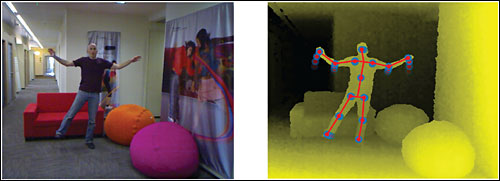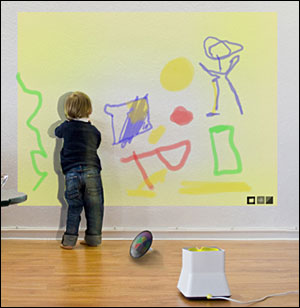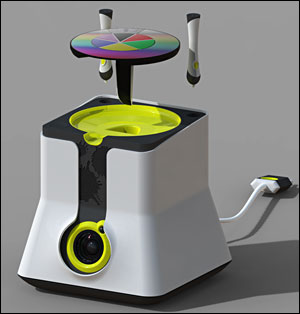By Hank Hogan, Contributing Editor
There's a second line to the famous phrase about work, play, and a boring boy named Jack. Supposedly, all play and no work makes Jack a mere toy. But when it comes to photonics at play, mere toys won't do. Instead it takes advanced light sources and motion-tracking sensors, along with sophisticated software, for success.
Done right, the result could be a big payoff. In gaming console hardware alone, potential sales could top hundreds of millions of dollars annually. To that must be added revenue from new games, proceeds from amusement parks, earnings from education-oriented efforts, and other income.
All of that money could come with a healthy dose of fun, in part because photonic devices can make for a more natural interface than a mouse or a controller.
"Now you can use your body and your hands for the same function. It gives you much more flexibility and is much more fun," said Uzi Breier, chief marketing officer and vice president of worldwide sales for PrimeSense of Tel Aviv, Israel.

Structured light creates a skeletonized 3-D image, allows gaming without controllers. (Photo: PrimeSense)
The privately held company makes vision-oriented digital devices that have a three-dimensional perception of reality. It supplies the technology behind the Kinect add-on to the Xbox 360, the game console from Redmond, Wash.-based Microsoft.
Utilizing a microphone, an RGB camera, an infrared light source and an accompanying sensor, the bar-shaped Kinect tracks player movements without the use of handheld controllers. The $150 device can be added to the 45 or so million Xbox 360 game consoles already in the field. Within 10 days of its early November debut, Microsoft reported over a million devices shipped.
The scheme works by sending out a structured beam of light, said Breier. This might be a grid of lines, intersecting to form a regular array of squares of a known size, for example. The mesh reflects off objects and is picked up by a sensor, with the deviations from the projected pattern yielding 3-D data. In the case of the PrimeSense technology, this information is from over 300,000 points for distances ranging from 50 cm to 5 m.

Infrared and visible light provide game playing through the Kinect Xbox 360 add-on created by PrimeSense of Tel Aviv, Israel. (Photo: Microsoft).
The Kinect does this using infrared light. For it and other applications, the data is abstracted into a skeleton, highlighting a finger, wrist or elbow. This simplification allows the system to track player movements faster.
Complementing the 3-D data, the RGB camera enables facial recognition and the extraction of player specific attributes. Finally, the microphone provides the mechanism for spoken commands.
Breier sees this as only the first application of hands-free, gesture based control in the living room. Instead of fumbling for a remote, people could, for instance, direct a TV or another device with more natural motions, fundamentally changing the interaction.
"You sit on the sofa. The TV sees it's you and identifies that it's 8 p.m.," said Breier. "It knows that you like to watch the news. So it flips on, automatically, the news. You don't have to do anything."
Another example of photonics at play comes from Sony, the Tokyo-based consumer electronics firm. The PlayStation 3 Move motion controller uses LEDs in the orb of a handheld controller, along with a camera attached to the game console, to track player movements. OmniVision Technologies of Santa Clara, Calif. worked with Sony in developing the sensor. Like its competitors, the PlayStation 3 has shipped tens of millions of units worldwide.
In addition to visible tracking, the controller has a pair of inertial sensors within it, along with a magnetometer. This multipronged approach overcomes the limitations inherent in a photonics-only implementation. Bright sunlight can defeat infrared-based schemes, and too little light can cripple visible facial recognition, something that showed up in independent testing of the Kinect.
Laurent Robin, an analyst with the Lyon, France-based market research firm Yole Développement, is predicting a global market for gaming motion sensors approaching a half billion dollars and about that many sensors a year by 2015. While advances make a photonics-only implementation possible, Robin foresees a different solution in which no one sensor technology is the sole answer.
"We believe that the future will be a fusion between all those type of sensors — image sensors, inertial, compass, lightbulbs, and perhaps RF," he said.

With lasers and sensors, laser tag provides family entertainment. (Photo: Delta Strike)
Laser tag is another area where photonics is a key to gaming success. There were over 1530 sites open worldwide in 2009, according to the International Laser Tag Association. That's 30 percent more than the number of sites open five years earlier and a modest increase over the previous year's 1497.
Each laser tag site has multiple phasers, the industry's preferred term for the laser equipped gun, and vests, which have sensors connected to targets via fiber optic cables. Hitting those sensors with an appropriately modulated light source leads to a player being tagged. The targets measure only three or so square inches, and players may be trying to hit them on moving opponents from across a room. As an added twist, the sensors may be somewhat edge on to the beam, making them appear even smaller.
For that reason, most of the industry uses two sources, a visible laser and an invisible infrared LED. The former is pencil thin, while the latter may be five inches or more in diameter at 30 ft. This dual approach, proponents say, makes game play more realistic and fun for the casual user, but it does require two aligned light sources. It also slightly increases the power demands, said Al Keeping, sales manager with equipment maker LaserBlast of Plymouth, Maine.
The core of the business is birthday parties, but over the last few years the nature of the game has changed, he said. "The business nowadays is really much more attraction entertainment than it is the classic laser tag center."
This evolution can be seen in the use of laser tag in amusement and theme parks, said Doug Willems. He's CEO of Delta Strike, a Christchurch, New Zealand based equipment maker. In a normal game, for instance, players are divided into two teams of equal capabilities. With the right setup, though, variations are possible with, for example, some players designated as leaders, others medics and still others snipers. Vests can also act as shields, protecting certain players for a set number of shots. Finally, objects in the arena can be interactive targets.
Delta Strike just introduced a new phaser, one equipped with a more powerful infrared source, and accompanying tighter specifications on the infrared receivers. As a result, it can work at distances of up to 30 meters.

Kids paint on walls without permanently marking them using a conceptual KLEXL smart projector (closeup below at left). (Images courtesy of Dario Jandrijic)
In January, Willems said the company is moving conventional laser tag into a new frontier: the outdoors. The sunshine in such settings presents a dual challenge. For one thing, it washes out both visible and invisible beams. Another problem involves the phaser display, typically an information packed LCD screen that must be easily seen.
"Such screens normally either work in sunlight or dark. Delta Strike has sourced a screen which can operate well in both environments," said Willems. A final example of photonics at play isn't a product — yet. But it could be someday, pleasing both kids and parents.
Dario Jandrijic, an industrial design student at the University of Wuppertal in Germany, has modernized the scrawling of art on walls by children and those young at heart. The conceptual system started out when Jandrijic began looking at whiteboards. These can be easily drawn on and erased but are too large for independent use by kids and are permanently attached to a wall.
 His solution is a specialized smart projector, housed in a small, Web-connected base unit. An infrared tracking camera within the unit follows the movement of LED tipped pens across a nearby wall, with the projector translating these into images on the ad hoc whiteboard. By tapping on a color wheel that charges atop the base wheel but is removed during use, kids can change the color being shown.
His solution is a specialized smart projector, housed in a small, Web-connected base unit. An infrared tracking camera within the unit follows the movement of LED tipped pens across a nearby wall, with the projector translating these into images on the ad hoc whiteboard. By tapping on a color wheel that charges atop the base wheel but is removed during use, kids can change the color being shown.
Jandrijic dubbed the device KLEXL as a play on the German word for blot, like a paint blob that falls from a brush. Although a working prototype has yet to be built, the device only requires off-the-shelf components, he said. Improvements in tracking technology would enhance the device's capabilities, as would a lower power projector or one that works in brighter environments.
As for the potential market for this fun photonic replacement of the traditional writing on walls, that could be quite large, he said. "Parents all over the world are interested in advancing their kids' creativity and expression without having smeared walls or furniture."
[email protected]